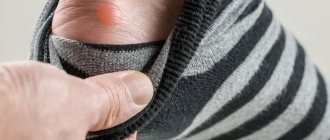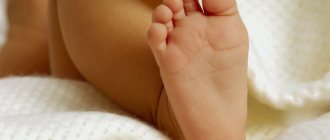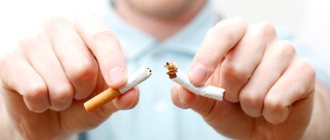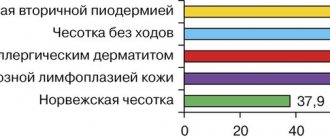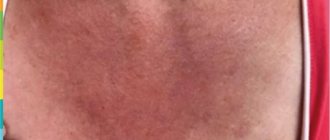05/27/2021 Reading time: 5 min 15990 0
By the end of the first month of life or a little later, yellowish crusty scales can be noticed on the baby’s scalp. They can frighten and upset a mother who is unprepared for such a phenomenon, but meanwhile there is nothing terrible about them. Milk crusts, which actually have nothing to do with milk, occur in many children under one year old. In medical terminology, they are called seborrheic dermatitis, physiological seborrhea or gneiss.
Reasons for appearance
A crust on the head of an adult can appear for various reasons:
- allergic manifestations;
- avitaminosis;
- excess weight;
- incorrectly selected cosmetics for hair care. Especially if it contains a large amount of alkali;
- excessive secretion of subcutaneous sebum;
- daily hair washing. Natural subcutaneous fat does not have time to be fully released, there is no protective lubricant and dandruff forms in the form of a crust;
- infrequent washing can also cause the formation of a crust of dandruff;
- metabolic disease;
- hormonal changes (puberty, pregnancy, lactation, menopause);
- an unbalanced diet when losing weight or excessive consumption of unhealthy foods (fatty, spicy, salty, fried, etc.);
- diseases of the gastrointestinal tract;
- excessive drinking and smoking;
- improper daily routine (lack of sleep is especially harmful);
- systematic drying of the skin that occurs when using thermal devices;
- stress.
All of the above factors are favorable for the main reason for the appearance of a crust on the scalp in adults - increased activity of a pathogenic fungus. It is present on the head of every person and is part of the microflora of the skin. In a healthy body, the fungus does not manifest itself in any way, but under the influence of the listed circumstances, it begins its active activity. This is how the manifestation of seborrheic dermatitis (wet or dry) begins. That is why almost all hair dandruff remedies are aimed at combating this fungus.
Two forms of oily seborrhea
Oily seborrheic dermatitis can appear in liquid and thick forms. In the liquid form, the hair begins to become shiny, as if it had been generously lubricated with oil. Due to the increased activity of the sebaceous glands, pores expand and a large amount of sebum is released onto the surface of the skin. The active activity of the Malassezia fungus, which quickly multiplies in sebum, leads to keratinization of the epidermis (the upper cover of the scalp), resulting in the formation of yellow particles, that is, yellow dandruff, which is not shaken off as easily as dry white dandruff. In addition, the process of dandruff formation is accompanied by frequent itching, which is caused by chemically active waste products of Malassezia. If no measures are taken for a long time, a person’s hair may begin to fall out, acne, boils and other purulent formations may appear. This is due to the fact that in some places it is difficult for the secretion to escape.
The thick form of the oily variety of seborrheic dermatitis is more dangerous because the skin pores become clogged due to the fact that sebum mixes with keratinized particles of the epidermis and the surface of the head becomes covered with a yellow crust. As a result, plugs form in the sebaceous ducts and the secretion cannot come out, which leads to the appearance of large purulent formations, for example, atheroma. The thick form, like the liquid one, is accompanied by severe itching.
What you need to know
Seborrheic crusts on the head are an inflammatory disease. The cause of its occurrence is a fungus that promotes natural exfoliation of the upper layers of the skin.
It is this that provokes the appearance of dandruff, and later a crust appears in the scalp. The fungus is most active on oily skin, but those with dry and normal hair can also become victims of seborrheic dermatitis.
At the first symptoms of the disease, the skin itches. After this, small reddish spots appear on the head, which peel off. A crust forms on the scalp from dead epidermal cells.
It can be easily separated and adhere firmly to the skin. In the latter case, its separation is associated with pain, and can also cause the formation of wounds and even ulcers. If no measures are taken, the itching intensifies, and the person notices that the head is covered with clearly visible dandruff.
At first, seborrheic dermatitis is not particularly dangerous. There is physical and aesthetic discomfort. It also creates a certain obstacle to hair growth in the area of crust formation. But if the problem is not dealt with, a bacterial infection is added to the disease. This means that in addition to a crust on the head, other diseases may appear. When the condition is severely neglected, hair begins to fall out, forming bald spots.
Signs of seborrhea most often appear in the autumn-winter period, when a person’s immunity is weakened.
Important! Dandruff is a fungal disease, and it can be transmitted through personal hygiene products: comb, towels, etc.
A crust of dandruff appearing on the scalp in children can be considered normal, but in adults it is a signal of alarming symptoms. If a flaky and itchy layer forms on the scalp, this is a reason to consult a doctor (trichologist or dermatologist) for a thorough examination. After all, it is not always the case that the scalp is covered with a white crust – this is a manifestation of fungal activity. White flaky formations can be a signal of more serious problems: psoriasis, scabies (the activity of the scabies mite), favus (the appearance of the achorion fungus, another name for the disease is scab, favus lichen), ringworm, etc.
The earlier the visit to a specialist, the easier the diagnosis is made and the faster the treatment.
Features of skin diseases
Dandruff
Impaired functioning of the sebaceous glands and excessive dryness of the skin lead to increased peeling. When scratched, the scales of the epidermis are separated; they can be white or yellowish in color. This is what dandruff looks like.
You can notice the appearance of dandruff on your head by visual inspection. In addition, the disease is accompanied by itching, the head begins to itch.
The main causes of dandruff are malfunctions of the sebaceous glands, infection with a fungus from a sick person. The disease can also appear against the background of nervous disorders and constant stress.
A regular comb will not get rid of the disease; targeted treatment will be required. Trichologists recommend special shampoos, medications, and prescribe a strict diet.
Psoriasis
The appearance of dry redness on the scalp, which over time “grow together” into large areas, so-called psoriatic plaques , indicates the development of psoriasis (lichen planus). The disease begins with a mild form. If treatment is not started on time, there is a high risk of complications and transition to a chronic form; the affected skin areas become much larger. You can see what psoriasis looks like in the photo.
The causes of psoriasis are not precisely determined. To treat the initial stage of the disease, ointments (salicylic or zinc ointment) are used; for more complex cases, corticosteroids are prescribed.
Important! It is impossible to delay the treatment of psoriasis; the disease progresses very quickly and can affect the functioning of internal organs.
Demodicosis
Disease of the scalp is caused by the activity of the subcutaneous Demodex mite. The parasite may not appear for a long time, but a weakened immune system contributes to the development of the disease.
Pimples, acne, purulent rashes and local redness of the skin that itch unbearably are the main signs of infection. Additional symptoms of the disease include lumpy skin, soreness in the scalp, and the appearance of a greasy sheen in the hair.
For treatment, drugs containing metronidazole are used. It is not possible to completely get rid of the pathogen, but you can stop its activity.
Seborrhea
Seborrheic dermatitis (seborrhea) is caused by increased activity of Malassezia fungi . They promote accelerated division of cells in the surface layer of the skin. Patients with seborrhea note abundant dandruff on the back of the head, in the bangs area, the head itches and quickly becomes fat. In more complex forms of the disease, patients begin to go bald.
There are many reasons for the development of scalp disease:
- genetic predisposition;
- improper, poor nutrition;
- disease of the gastrointestinal tract;
- decreased immunity;
- nervousness and frequent stress.
To treat the disease, special shampoos with the addition of salicylic acid, zinc, and coal tar are used. An equally important step in eliminating skin problems is the regulation of metabolic processes through a strict diet.
Allergic dermatitis
The very name of the disease indicates the reason for its development - it is an allergy to a drug, product, hair dye or cosmetic product used. Symptoms of the sore appear immediately or some time after contact with the allergen: swelling, redness, papules appear, turning into ulcers and weeping sores.
Attention! To eliminate the problem, it is enough not to contact the allergen; the doctor prescribes antihistamines and ointments with corticosteroids.
Pediculosis
The causative agent of the disease is the head louse, which can move freely. Pediculosis can be caused by regular stress, poor personal hygiene and sanitation, as well as contact with a carrier of the infection. Frequent patients are children who attend kindergarten or school.
Symptoms of the sore:
- ulcerative lesions accompanied by itching;
- irritability of the patient;
- slight discomfort may occur.
To treat pediculosis, special ointments and shampoos are used. To prevent the recurrence of the disease in the future, it is recommended to avoid potentially dangerous individuals, use a personal comb, and monitor hygiene and sanitation. 2 days after recovery, change the bed linen, do a general cleaning, and treat with hot steam the areas where the removed lice may have ended up.
Scabbers
Scabs on the scalp are contagious diseases; contact with a sick person is dangerous for a healthy person. The causative agent of the disease is scabies. In 12 hours, fertilized female parasites can lay up to 4 eggs; after 2 weeks, new individuals will emerge from them. The saliva of the scabies mite destroys keratin and facilitates the process of infection of the skin by it; “intradermal scabies tracts” are formed in it for the laying of parasite eggs. There is no point in delaying treatment of the disease.
Scabs on the head, in addition to unpleasant itching in the evening and at night, are accompanied by various kinds of rashes. The resulting papules may simply rise on the scalp or contain a liquid component. It is forbidden to scratch the sores, so as not to cause infection and not to provoke suppuration.
The cause of the disease remains contact with a sick person or animal; infection is possible through household items and personal belongings of the patient.
If scabs appear on your head, contact a specialist immediately. When treating, it is first of all important to get rid of the cause of the disease and not to contact the patient. Then acaricidal preparations for external use are prescribed.
Microsporia
This type of sore on the head is more common in children than in adults. The appearance of crusts, scales, acne of various shapes and sizes. Causes of the pain:
- malfunction of the sebaceous glands;
- contact with the patient;
- weakened immune system;
- lack of microelements and vitamins in the body.
To treat the disease, the doctor will recommend the drugs Terbinafine, Clotrimazole, and their analogues. Rubbing vegetable oils into the skin in combination with salicylic acid will be useful.
Weeping sores
Weeping sores on the head are a common phenomenon. Red lumps and small rashes appear on the skin, causing discomfort and itching. In a more complex stage of the disease, purulent formations and bleeding are observed.
There are enough reasons for the appearance of the disease:
- stress;
- weakness, vulnerability of the body to attacks of infections;
- diseases of internal organs;
- disruptions in the gastrointestinal tract.
To eliminate sores, medicinal ointments and preparations for external use are prescribed, hirudotherapy (leech treatment) and mesotherapy are used.
Attention! Do not try to diagnose the disease yourself and prescribe therapy for yourself. This is dangerous due to the worsening of the disease, consult a highly qualified doctor. Many head sores have similar symptoms, but differ in treatment.
Tips and tricks to resolve the problem
To get rid of crust on the scalp, it is important:
- find out from the doctor why the flaky areas appeared;
- strengthen the immune system. This will help: a course of vitamins, exercise, sufficient consumption of vegetables and fruits, giving up alcohol and tobacco;
- eliminate stressful conditions;
- drink about 2 liters of pure water per day;
- stick to a healthy diet (avoiding fatty, spicy, etc.). Normal activity of the gastrointestinal tract will reduce the formation of affected areas;
- choose shampoos and other caring cosmetics without aggressive ingredients. It is better to take plant-based products;
- get rid of the allergen, if we are talking about allergic manifestations of dandruff;
- use medicinal cosmetics prescribed by the doctor.
Folk remedies also give good results as a complete treatment, or complementing drug treatment.
After successful therapy, dandruff in the form of a crust on the epidermis may return, especially if you do not adhere to a healthy lifestyle.
Diagnosis of pathology
If there is a suspicion of seborrheic dermatitis, a dermatologist will first examine the affected areas of the skin. With typical symptoms, the diagnosis is usually confirmed. However, dandruff and flakes can also cause other skin conditions:
- psoriasis;
- eczema;
- herpes zoster or pityriasis versicolor.
To distinguish the disease, a dermatologist may take a scraping of dandruff and, if in doubt, a deeper sample of skin tissue for histological examination.
Drug treatment
If you ask your doctor how to get rid of crusts, he may recommend ointment (applied with a cotton swab), shampoo (frequent washing) or a combination of these products. In particularly advanced cases, antibiotic therapy and other alternative methods are prescribed.
Effective drugs
Sulsena
It is a favorite among other means of combating the problem. The main active component is selenium disulfide. Normalizes the condition of the skin, reduces fungal activity, normalizes the functioning of the sebaceous glands, has an exfoliating effect and restorative properties.
It is used both as a shampoo for scalp crusts and as a paste. Often both remedies are used in combination. The cost of shampoo or peeling shampoo is about 300 rubles, the paste is about 120 rubles.
Naftaderm
The main component of the ointment is Naftalan refined oil. It is used for any diseases that result in the formation of a dry crust on the head of an adult. Use twice a day for a month. The cost of the drug is within 500 rubles.
Attention! It is recommended to combine therapy with emollient creams and oils to avoid excessive dryness of the skin.
Keto plus
The active ingredients of the shampoo are zinc pyrithione and ketoconazole. Effective in the treatment of dandruff caused by Malassezia furfur (yeast microorganisms). The course of treatment depends on the type of disease and is carried out according to the scheme. The cost of Keto Plus ranges from 720 rubles.
Salicylic ointment
It is based on salicylic acid, which has antiseptic and regenerating properties. Softens dry crusts and relieves inflammation. Treatment lasts from 6 to 20 days. Depending on the type of disease and the general condition of the skin, it is used both in pure form and diluted with Vaseline. The most affordable product, the price of which ranges from 25 rubles.
What other types of dandruff are there?
(6)
- Yellow dandruff, caused by the related fungus Malassezia globosa, is characterized by flaking yellow scales. Some symptoms are similar to all types of dandruff: yellow particles peel off from the surface of the scalp, the functioning of the sebaceous glands is disrupted, hair loss and the development of other, more serious forms of dermatitis are possible.
- White or gray-white dandruff is characteristic of dry seborrhea. At the same time, the sebaceous glands do not work enough, not producing the required amount of secretion, as a result of which the skin begins to dry and peel, which leads to the appearance of white dandruff.
- Red, or rather, reddish dandruff is called so conventionally. Occurs when there is inflammation of the epidermis, which is affected by fungal infections or suffers from dermatitis. A person combs the diseased areas until they bleed, causing dead white-pink particles to fall off.
- Black dandruff is not actually dandruff, but acne peeling and remnants of acne and other formations protruding on the skin, as well as coagulated blood that was picked off while combing the head.
Brown dandruff may not be dandruff at all, since this color often develops with lice. (7)
Folk remedies
If the disease is not advanced, you can get rid of it with the help of alternative medicine, or combine such methods with medical prescriptions.
Henna
It is one of the most popular remedies in the fight against dandruff.
How to use: pour 60 g of powder with boiling water (you need enough water to get the consistency of sour cream), then cool. You can also dilute the ointment with rosemary and/or tea tree essential oils. Apply to affected areas for half an hour and rinse with warm water.
To prevent your curls from becoming colored, it is better to use colorless henna. The recipe can be supplemented with a decoction of St. John's wort, apple cider vinegar, orange juice, burdock oil, and blue clay.
Unripe (green) walnut
Option #1. 100 g of crushed nut shells are poured with vodka (0.5 l) and infused for 2 weeks. Afterwards the infusion is filtered. Used by massaging into the skin every other day for 20 days.
Option #2. 300 g of crushed leaves, peel and shell are poured into a liter of water and brought to a boil in a water bath. Then the broth is removed from the heat and infused for 2 hours.
How to use: As a rinse after washing your hair. Afterwards, wrap your head in a towel and leave for at least 10 minutes. Repeat the procedure 3-5 times. The effect is noticeable from the first use.
Important. Walnut can dye strands a dark color, so it is better not to use it on light-colored hair.
Kefir
Apply with rubbing movements to the entire surface of the scalp and leave for half an hour. Wash off with rinse aid (1 tbsp dry mustard diluted in 1 liter of warm water). Do it daily for a week. Then repeat the procedure for preventive purposes once a month.
Burdock root
The young root of the plant is crushed (in a meat grinder or grater) and mixed with vegetable oil (1:3). Next, the mixture must be infused for an hour in a glass jar. Then strain and rub into the skin 2-3 times a week. Warm up before use. There should be a total of 10 such rubbings. The next course is repeated after 20 days.
Burr oil
When heated, apply to the scalp. Then the head must be covered with polyethylene, wrapped in a towel and left for 2 hours. Rinse off.
nettle leaves
A tablespoon of crushed leaves is poured into a glass of boiling water. The resulting infusion must be covered, wrapped and kept for 1.5 hours. Strain. Apply to skin after washing, cover head with a bag and leave for 40 minutes. There is no need to wash your curls after the procedure. Use the product twice a week.
Chamomile flowers
Boil table 2. spoons of flowers with 1 liter of water. Cool and strain. Dilute with plain water in a ratio of 1:10 and rinse your hair after washing three times a week. Do 15 procedures, then pause for 3 weeks and repeat the course again.
Chamomile gives light strands a golden hue.
Sage
Infuse for 1 table. spoon of dry sage herb with 1 glass of boiling water for 24 hours. Rub in every other day for a month. This remedy is good for dry seborrhea. For oily dandruff, replace the water in the recipe with a glass of vodka.
Tea tree oil
Powerful antiseptic. For treatment, it is better to add it to shampoo. In its pure form it can cause burns.
Oak bark
For medicinal purposes, you need to prepare an infusion of a tablespoon of bark, poured with 400 ml of boiling water. All this is infused in a water bath for 5 minutes, then filtered. Rub the infusion into the scalp 3-4 times a day, adding a tablespoon of flower honey to the liquid.
Alternative Methods
Used in especially severe cases.
Photochemotherapy
Comprehensive approach:
- taking special drugs that create fluorescence, psoralens orally;
- exposure to a prescribed dose of UVA.
Depending on the severity of the disease, different treatment regimens are used. They all come down to two phases: cleansing (2-3 sessions per week until symptoms disappear) and maintenance (once a week for a month, can be extended at intervals of once a month).
Important! Photochemotherapy is contraindicated in children. Women should use contraception to prevent pregnancy during treatment.
Laser therapy (physiotherapy)
Prescribed as an additional means of combating dandruff. The treatment is carried out with a laser beam that focuses photons (low intensity light). Photons improve blood circulation and help activate enzyme metabolism, resulting in the restoration of damaged tissue.
Plasmolifting (plasmotherapy)
The procedure involves subcutaneous injections obtained as a result of processing the patient’s blood in a special centrifuge (obtaining plasma rich in platelets and active components). It not only relieves dandruff and itching, but also helps with other hair problems (loss, weakened condition, etc.).
Plasmolifting has a number of contraindications, which include:
- allergy to anticoagulants;
- chronic or acute diseases;
- menstruation period;
- presence of tumors, hematomas;
- autoimmune diseases;
- pregnancy and lactation.
Vitamin therapy
Recommended for vitamin deficiency resulting in dandruff. The complex of vitamin preparations must include vitamins and microelements: A, F, E, B (1–6, 8, 9, 12), H, C, selenium.
Tips for those suffering from eczema
If you have a genetic predisposition or have already experienced eczema, you should be extremely careful by following these recommendations:
- avoid wearing clothes made of synthetic, wool or flannel fabric;
- include in your diet more vegetable dishes, boiled meat, fermented milk products, fruits (except for those that can provoke allergies: oranges, strawberries, raspberries, tangerines);
- avoid gastronomic experiments, alcohol, too spicy, salty and fatty foods, marinades;
- take vitamin complexes, in particular vitamins A and B are important;
- avoid contact with suspected allergens in everyday life (powders, detergents, etc.);
- in case of a history of varicose veins, wear rubber stockings and bandage the legs with medicinal bandages;
- be as nervous as possible;
- Visit a dermatologist periodically.
At the MediLife clinic in St. Petersburg, highly qualified experienced dermatologists and trichologists receive treatment. You can make an appointment online. Prices for services are presented on the website. You can clarify any details by phone. Friendly staff, the ability to choose a convenient time to visit and complete anonymity are pleasant and significant additions to the qualified consultation that will be provided at MediLife.
How soon can you get rid of
It all depends on the severity of the disease and how carefully the doctor’s recommendations are followed. The general condition of the body also plays an important role.
On average, the effect of treatment is noticeable after 4 or more weeks. By using pharmaceutical and folk remedies, you can achieve stable remission in the fight against the disease. And following a proper lifestyle will prevent dandruff from appearing in the future.
Like any other disease, dandruff is easier to prevent than to treat. But even if a problem appears, you can achieve positive results quickly. The main thing is to see a doctor in time and follow all his instructions.
In addition, the effectiveness of the fight against seborrhea can be enhanced by using traditional medicine recipes and other alternative methods. But all these steps need to be discussed with your doctor. This will help avoid side effects and create positive dynamics of recovery.

